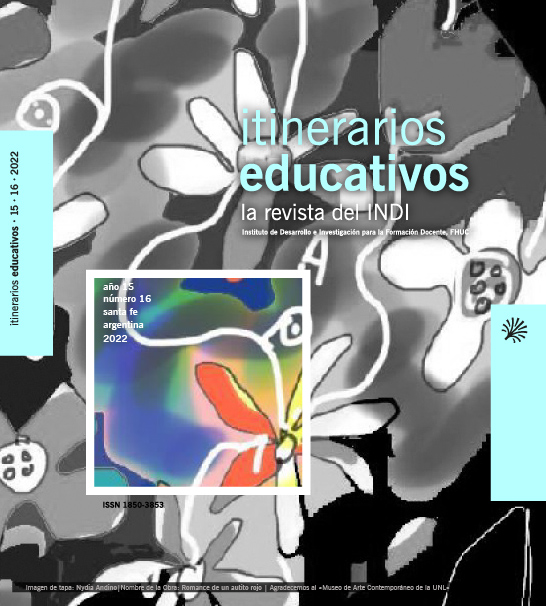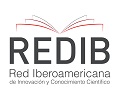Estrategias didácticas en Tecnología Educativa: simulación y trabajo colaborativo en la formación universitaria de grado
DOI:
https://doi.org/10.14409/ie.2022.16.e0027Palabras clave:
enseñanza universitaria, estrategia didáctica, simulación, trabajo colaborativoResumen
El contexto de pandemia Covid–19 y la emergencia de medidas sanitarias impactaron fuertemente en el sistema educativo, en general. Particularmente, en la universidad las prácticas de enseñanza presenciales debieron trasladarse a la virtualidad de manera inmediata, adquiriendo rasgos de la enseñanza remota de emergencia.
En el escrito se socializa una experiencia pedagógica correspondiente a la asignatura Tecnología Educativa de la Facultad de Humanidades de la Universidad Nacional del Nordeste (UNNE). La misma se desplegó en tres etapas concatenadas que apuntaban al montaje de planificaciones didácticas en aulas virtuales. Se destaca para su análisis, las estrategias didácticas transversales, la simulación en entornos virtuales y el trabajo colaborativo disciplinario e interdisciplinario, con sus contribuciones en la formación profesional docente.
Ideas clave que emergieron del análisis de encuestas realizadas a los estudiantes hacia el final de la cursada en las cuales se valoraron dichas estrategias. Las conclusiones iniciales dan cuenta de la relevancia que adquieren este tipo de estrategias didácticas para la formación docente ya que permite situar a los estudiantes, futuros profesionales, en el contexto de práctica real y en la toma decisiones para la resolución de situaciones problemáticas emergentes.
Citas
Brown, J.S.; Collins, A.; Duguid, P. (1989). Situated cognition and the culture of learning. Educational researcher, 18(1), 32–42. Recuperado de: https://doi.org/10.3102/0013189X018001032
Chaljub Hasbún, J.M. (enero–junio 2014). Trabajo colaborativo como estrategia de enseñanza en la universidad. Cuaderno de Pedagogía Universitaria Año 11 (22), 64–71. Recuperado de: http://investigare.pucmm.edu.do:8080/xmlui/bitstream/handle/20.500.12060/593/CPU_20141122_64-71.pdf?sequence=1&isAllowed=y
Esteban, P.G.; Tosina, R.Y.; Delgado, S.C.; Fustes, M.L. (2011). Buenas prácticas en el desarrollo de trabajo colaborativo en materias TIC aplicadas a la educación. Profesorado. Revista de currículum y formación de profesorado, 15(1), 179–194. Recuperado de: https://www.redalyc.org/pdf/567/56717469013.pdf
Fardoun, H.; Yousef, M.; González–González, C.; Collazos, C.A. (2020). Estudio exploratorio en Iberoamérica sobre procesos de enseñanza–aprendizaje y propuesta de evaluación en tiempos de pandemia. Artículo N° 17. Recuperado de: https://repositorio.grial.eu/bitstream/grial/2091/1/23537-79772-1-SM.pdf
Gaintza–Jauregi, Z. (2020). La simulación como estrategia metodológica en la Facultad de Educación de la Universidad del País Vasco. Revista Electrónica Educare, 24 (3), 233–250. Recuperado de: https://dx.doi.org/10.15359/ree.24-3.11
Hodges, Ch.; Moore, S.; Lockee, B.; Trust, T.; Bond, A. (2020). La diferencia entre la enseñanza remota de emergencia y el aprendizaje en línea. Recuperado de: https://er.educause.edu/articles/2020/3/the-difference-between-emergency-remote-teaching-and-online-learning
Kuklinski, H.P.; Cobo, C. (2020). Expandir la universidad más allá de la enseñanza remota de emergencia. Ideas hacia un modelo híbrido post-pandemia. Barcelona: Outliers School.
Maggio, M. (2018). Reinventar la clase en la universidad. Ciudad Autónoma de Buenos Aires: Paidós.
Maldonado Pérez, M. (2007). El trabajo colaborativo en el aula universitaria. Laurus, 13(23), 263–278. ISSN: 1315–883X. Recuperado de: https://www.redalyc.org/articulo.oa?id=76102314
Moreyra, M.; Alegre, M.; Demuth, P. (2021). Aprender y evaluar en la virtualidad: experiencia pedagógica de los profesores de la Universidad Nacional del Nordeste, en un curso de posgrado. Revista Iberoamericana de Tecnología en Educación y Educación en Tecnología, 28, pp. 414–422, 2021, doi: 10.24215/18509959.28.e52
Orozco Alvarado, J.C.; Cruz Acevedo, A.A.; Díaz Pérez, A.A. (2020). Simulación como estrategia didáctica en las prácticas de formación docente. Experiencia en la carrera Ciencias Sociales. Revista Torreón Universitario, 9(25), 16–28. Recuperado en: https://doi.org/10.5377/torreon.v9i25.9851
Ordorika, I. (2020). Pandemia y educación superior. Revista de la educación superior, 49(194), 1–8. Recuperado de: http://www.scielo.org.mx/scielo.php?script=sci_arttext&pid=S0185-27602020000200001
Quispe Pari, D.J.; Sanchez Mamani, G. (2011). Encuestas y entrevistas en investigación científica. Rev. Act. Clin. Med [online]. (10), pp. 490–494. Recuperado de: http://www.revistasbolivianas.org.bo/scielo.php?script=sci_arttext&pid=S2304-37682011000700009&lng=es&nrm=iso
Román, J.A.M. (2020). La educación superior en tiempos de pandemia: una visión desde dentro del proceso formativo. Revista Latinoamericana de Estudios Educativos (México), 50, 13–40. Recuperado de: https://www.redalyc.org/jatsRepo/270/27063237017/27063237017.pdf
Publicado
Cómo citar
Número
Sección
Licencia
Aviso de derechos de autor/a
Los autores que publican en esta revista están de acuerdo con los siguientes términos:
- Los autores conservan los derechos de autor y garantizan a la revista el derecho de ser la primera publicación del trabajo al igual que licenciado bajo una Creative Commons Attribution License que permite a otros compartir el trabajo con un reconocimiento de la autoría del trabajo y la publicación inicial en esta revista.
- Los autores pueden establecer por separado acuerdos adicionales para la distribución no exclusiva de la versión de la obra publicada en la revista (por ejemplo, situarlo en un repositorio institucional o publicarlo en un libro), con un reconocimiento de su publicación inicial en esta revista.
- Se permite y se anima a los autores a difundir sus trabajos electrónicamente (por ejemplo, en repositorios institucionales o en su propio sitio web) antes y durante el proceso de envío, ya que puede dar lugar a intercambios productivos, así como a una citación más temprana y mayor de los trabajos publicados (Véase The Effect of Open Access).












